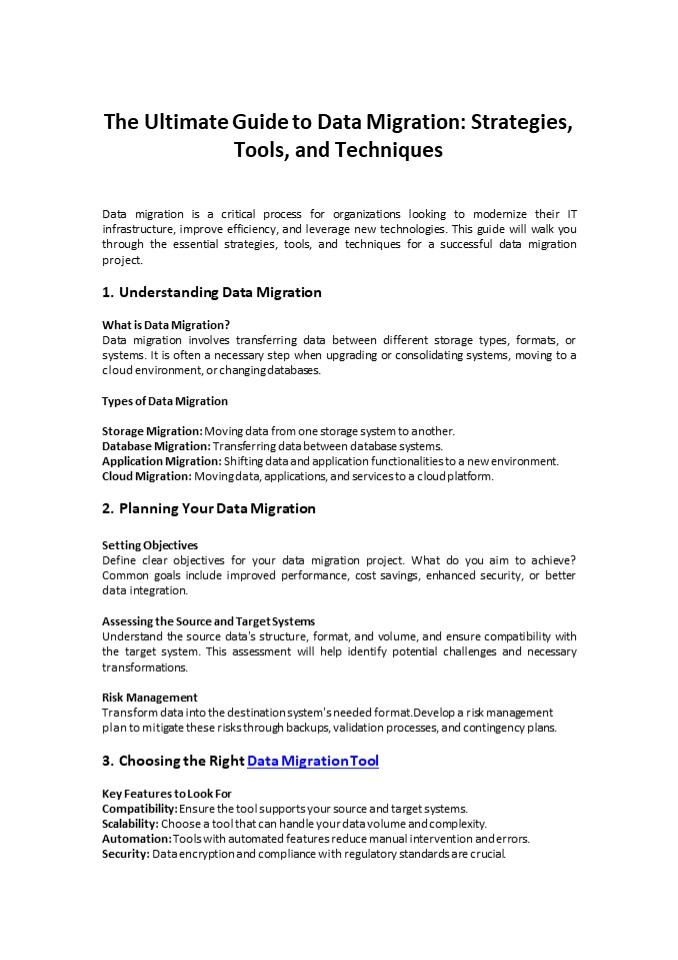The Ultimate Guide to Data Migration - PowerPoint PPT Presentation
Title:
The Ultimate Guide to Data Migration
Description:
Data migration is a critical process for organizations looking to modernize their IT infrastructure, improve efficiency, and leverage new technologies. This guide will walk you through the essential strategies, tools, and techniques for a successful data migration project. – PowerPoint PPT presentation
Number of Views:0
Title: The Ultimate Guide to Data Migration
1
The Ultimate Guide to Data Migration Strategies,
Tools, and Techniques
- Data migration is a critical process for
organizations looking to modernize their IT
infrastructure, improve efficiency, and leverage
new technologies. This guide will walk you
through the essential strategies, tools, and
techniques for a successful data migration
project. - Understanding Data Migration
- What is Data Migration?
- Data migration involves transferring data between
different storage types, formats, or systems. It
is often a necessary step when upgrading or
consolidating systems, moving to a cloud
environment, or changing databases. - Types of Data Migration
- Storage Migration Moving data from one storage
system to another. - Database Migration Transferring data between
database systems. - Application Migration Shifting data and
application functionalities to a new environment. - Cloud Migration Moving data, applications, and
services to a cloud platform. - Planning Your Data Migration
- Setting Objectives
- Define clear objectives for your data migration
project. What do you aim to achieve? Common goals
include improved performance, cost savings,
enhanced security, or better data integration. - Assessing the Source and Target Systems
- Understand the source data's structure, format,
and volume, and ensure compatibility with the
target system. This assessment will help identify
potential challenges and necessary
transformations.
2
- Popular Data Migration Tools
- Ask On Data The premier Data Migration Tool, for
seamless and efficient data transfer. - Fivetran Known for its ease of use and automated
data pipeline creation. - Microsoft Data Migration Assistant Ideal for
migrating to SQL Server or Azure SQL Database. - AWS Database Migration Service Supports
migration to and from Amazon databases. - Hevo Data Offers real-time data migration with
minimal setup. - Data Migration Strategies
- Big Bang Migration
- A one-time migration event where the entire data
set is moved at once. This approach is faster but
riskier due to potential downtime and data loss. - Trickle Migration
- Involves a phased approach, migrating data in
stages. This reduces risk and allows for
continuous operation, but the process is longer
and more complex. - Data Migration Process
- Data Profiling
- Analyze the source data to understand its
structure, quality, and any necessary
transformations. - Data Cleansing
- Identify and correct errors, duplicates, and
inconsistencies in the source data to ensure
accuracy and quality.
3
7. Best Practices for Data Migration Plan
Thoroughly Detailed planning reduces the risk of
unexpected issues. Automate Where Possible
Automation tools minimize manual errors and speed
up the process. Validate Continuously Regular
validation ensures data integrity throughout the
migration. Communicate Clearly Keep all
stakeholders informed to ensure alignment and
address concerns promptly. Conclusion Data
migration is a complex but essential process for
modernizing IT infrastructure and improving
organizational efficiency. By understanding the
different types of migrations, planning
effectively, choosing the right tools, and
following best practices, you can ensure a
successful data migration project. For more
detailed information and resources, visit Ask On
Data.

